Extraordinary Fossil Find Reveals Details About the Weight and Diet of Extinct Saber-Toothed Marsupial
A 13-million-year-old saber-toothed marsupial skeleton discovered during paleontological explorations in Colombia is the most complete specimen recovered in the region.
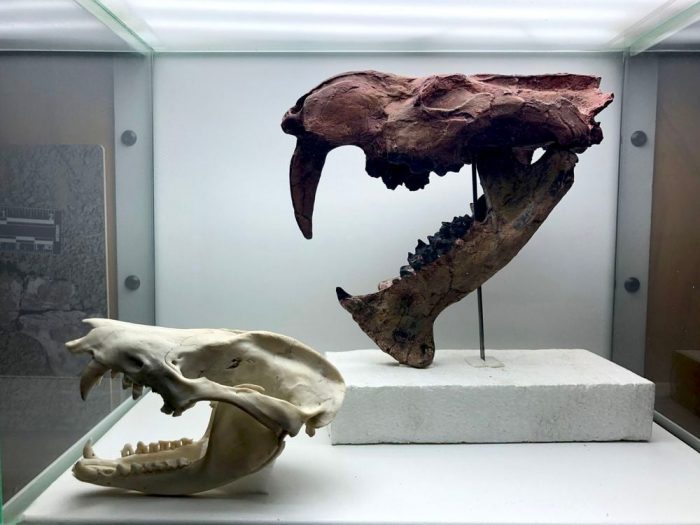
Sabretooth and marsupial opossum skulls. (Photo by Javier Luque)
Recent paleontological explorations in the Tatacoa Desert in Colombia led to the recovery of the most complete skeleton of a “saber-toothed marsupial” discovered in northern South America. The specimen belongs to the species Anachlysictis gracilis, which is part of a group of extinct predatory mammals known as sparassodonts, that lived in South America during the Cenozoic, after the extinction of the dinosaurs.
This species lived approximately 13 million years ago in the area known among paleontologists as ‘La Venta’, in the current La Tatacoa desert, a tropical dry forest that “at that time was a tropical rainforest, similar to the current Amazon,” said Dr. Catalina Suarez, a Swiss National Science Foundation fellow working at the Argentine Institute of Nivology, Glaciology and Environmental Sciences, who led the analysis of the remains and the publication of their results in the scientific journal Geodiversitas.
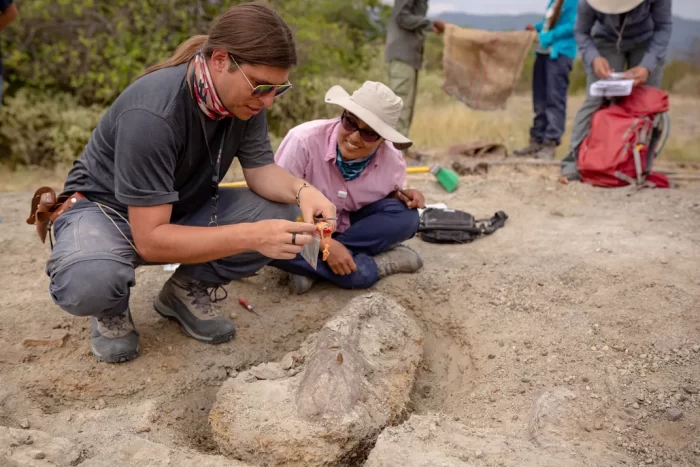
Lead author Catalina Suarez (IANIGLA, Argentina, center) and co-author Javier Luque (University of Cambridge Museum of Zoology, UK) excavating Miocene vertebrates in the La Venta area where the saber-toothed marsupial was discovered. (Felipe Villegas, Humboldt Institute)
Prior to this finding, only a piece of a mandible and few additional remains had been found for this species related to living marsupials such as kangaroos, koalas, or opossums. Before it disappeared, A. gracilis was one of a number of terrestrial carnivores in South America, like the pumas, wildcats, foxes, bears and others that currently roam our continent.
“Thanks to this discovery, we were able to learn new details about this fascinating species,” said Suarez. “The analyses allowed us to understand what these extinct predators were like and how they lived in Neotropical South America millions of years ago.”
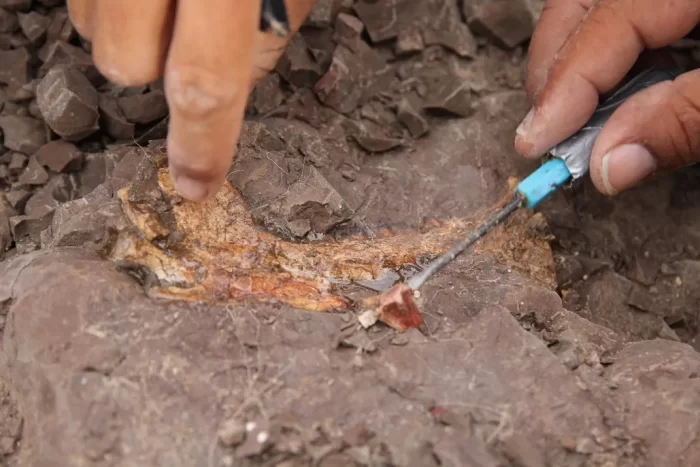
Extraction of the new specimen (the left side of the mandible, which was still buried, can be observed). (Aldo Benites-Palomino)
Suarez began her research on A. gracilis in the laboratory of paleontologist Carlos Jaramillo at the Smithsonian Tropical Research Institute, where she was an intern and a pre- and post-doctoral fellow. She is now a specialist in metatherians, the group that includes marsupials and their extinct relatives, such as the family of Thylacosmilidae to which the fossil of A. gracilis belongs. The most peculiar feature of this family is their curved and flattened canines, resembling the shape of a saber, so they are commonly known as “saber-toothed marsupials”.
“Our research confirms that this Colombian fossil ‘saber-tooth marsupial’ A. gracilis, is closely related to Thylacosmilus, which is the most widely recognized ‘saber-tooth marsupial,” said Dr. Javier Luque, a former STRI fellow, co-author of the study and senior research associate at the University of Cambridge Museum of Zoology. “Both groups, together with Patagosmilus (another one of these ‘saber-tooth marsupials’), form their own family in the mammal tree of life, known as Thylacosmilidae. This family is characterized by its long and enormous curved and saber-shaped upper canines, and by an extension of the anterior part of the jaw that looks like the sheath of said ‘sabers.”
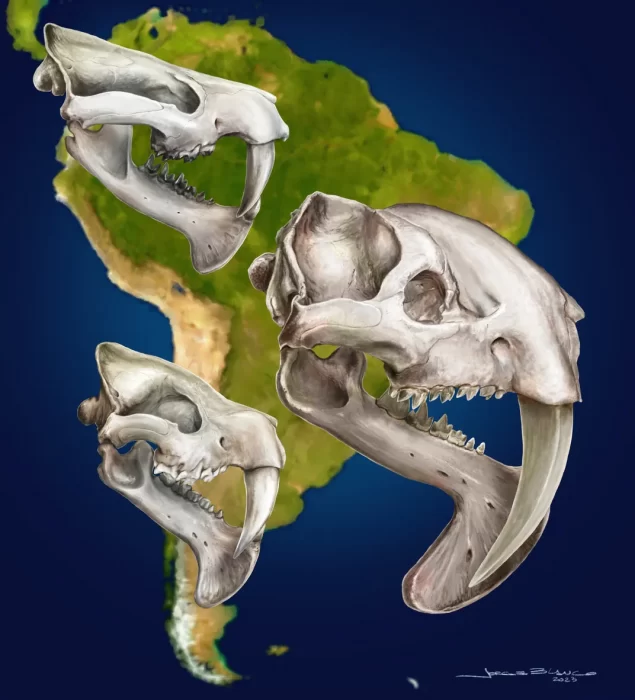
The three species of the family Thylacosmilidae on the South American continent: Anachlysictis gracilis (left, above), Thylacosmilus atrox (right) and Patagosmilus goini (left, below). (Artist: Jorge Blanco)
By analyzing the molar teeth, tooth shape and mandible of the remains, it was possible to define the approximate weight and diet type of A. gracilis. The results revealed that it weighed on average about 23 kg (like a lynx) and was a hypercarnivore that ate only meat, not bone. Its potential prey would have included small mammals that inhabited the area, such as marsupials, spiny rats, porcupines, rodents of various sizes and even primates, which were very abundant in the region.
“In a future study we will address all the other bones in its body, which include various sections of the spine, ribs, hip, scapulae —what we call ‘shoulder blades’ for humans— and bones in its legs,” Suarez said. “This will allow us to explore aspects of how it moved, the position in which its neck held its head, whether it was a runner, whether it could climb, whether its hands could hold objects more easily, as many marsupials do when feeding, or whether it was a bit more difficult, as it is for example for a dog or a cat.”
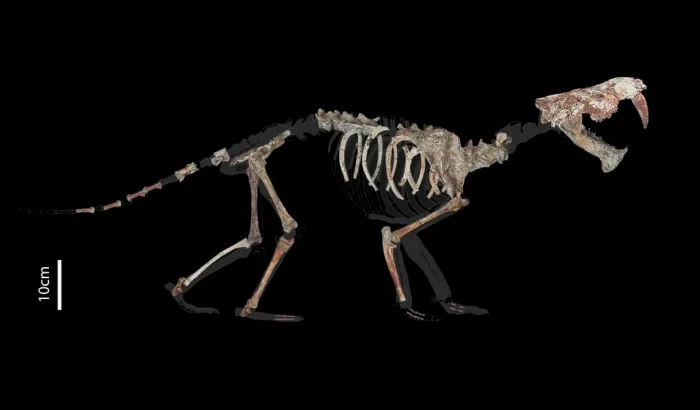
Scheme of the skeleton of Anachlysictis gracilis with the recently discovered remains. (Photography and design: Daniella Carvalho and Aldo Benites-Palomino.)
The new fossil of A. gracilis is housed in the La Tatacoa Natural History Museum, in the town of La Victoria in the municipality of Villavieja (department of Huila, Colombia), along with other surprising finds that have been unearthed in one of the most amazing places on the continent.
“The fossil specimen of A. gracilis that we describe in this research constitutes an iconic fossil because of its excellent preservation, three-dimensionality, and importance for understanding the paleobiological aspects of this predatory marsupial that roamed the forests of northern South America approximately 13 million years ago,” added Dr. Edwin Cadena, researcher at Universidad del Rosario and STRI, and co-author of the study. “With this finding we show the importance of continuing to support paleontological scientific activity in the Neotropics, in order to be able to make new discoveries that will help us understand the evolutionary history and paleobiodiversity of this part of the continent.”
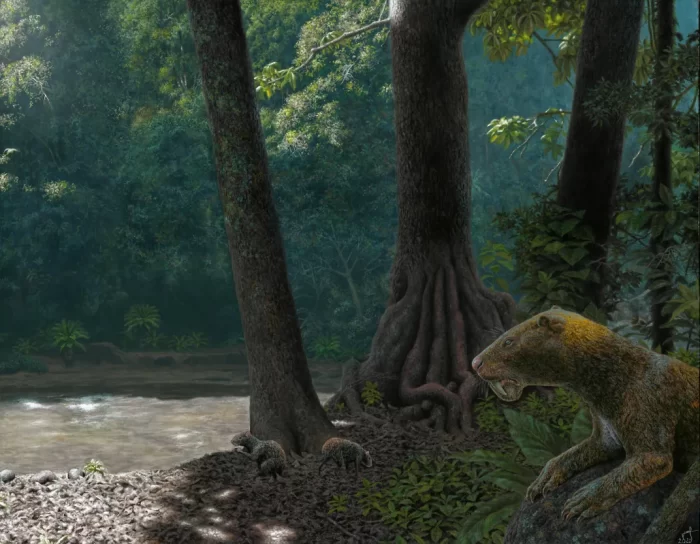
Anachlysictis gracilis stalking its prey in the La Venta area of Colombia, 13 million years ago. Artist: Juan Giraldo
This research was the result of an international collaboration between specialists representing institutions from Argentina (IANIGLA-CCT Conicet Mendoza, Museo de La Plata and Unidad Ejecutora Lillo-CONICET, Fundación Miguel Lillo), Colombia (Universidad del Rosario and Museo de Historia Natural La Tatacoa), United States (Field Museum of Natural History), Japan (Ashoro Museum of Paleontology), Panama (Smithsonian Tropical Research Institute) and United Kingdom (University of Cambridge).
_________________________________

Leila Nilipour is a bilingual storyteller based in Panama City.
This post was originally published by the Smithsonian magazine blog, Smithsonian Voices. Copyright 2023 Smithsonian Institution. Reprinted with permission from Smithsonian Enterprises. All rights reserved. Reproduction in any medium is strictly prohibited without permission from Smithsonian Institution.
Posted: 13 October 2023
-
Categories:
Collaboration , Feature Stories , Science and Nature , Tropical Research Institute







